Last updated on March 12th, 2021
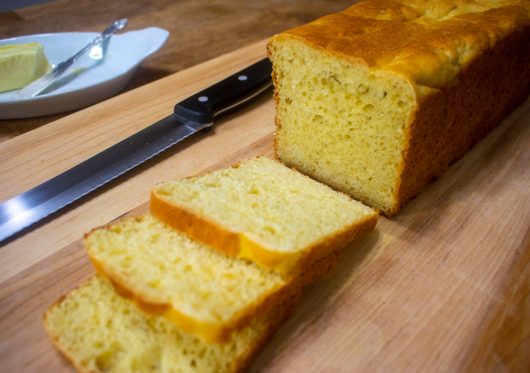 Sally Lunn is an 18th century bread made from flour, yeast, milk, and eggs. I love it for toast, French toast, and for simply topping with good butter and homemade strawberry jam. It’s certainly an easy bread to make. The only special equipment you’ll need is a stout spoon! My video and printable recipe for this luxurious loaf:
Sally Lunn is an 18th century bread made from flour, yeast, milk, and eggs. I love it for toast, French toast, and for simply topping with good butter and homemade strawberry jam. It’s certainly an easy bread to make. The only special equipment you’ll need is a stout spoon! My video and printable recipe for this luxurious loaf:
Sally Lunn (Batter Bread): The Video Recipe
Click the “play” arrow to watch the video. And please forgive the occasional critiquing from Tiger the Cat. She’s the most judgmental feline you will ever encounter.
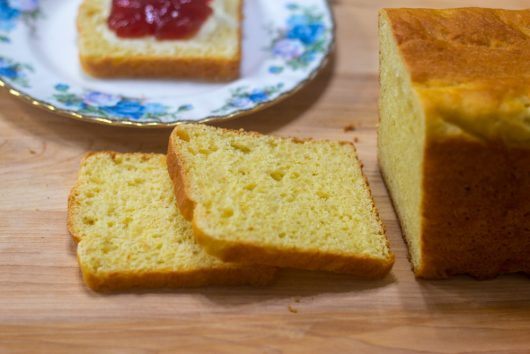
Historical notes, per Wikipedia:
There is little historical evidence for Sally Lunn as a person. The Gentleman’s Magazine of 1798 uses Sally Lunn as an example during a discussion of foods named after people—”a certain sort of hot rolls, now, or not long ago, in vogue at Bath, were gratefully and emphatically styled ‘Sally Lunns'”.[8] But it is not until 1827 that a historical person is described by a correspondent of William Hone using the pseudonym “Jehoiada“, who says she had sold the buns on the street “about thirty years ago”.[9] A baker called Dalmer had bought out her business and made it highly successful after he composed a special song for the vendors,[9] who sold the buns from mobile ovens. The earliest evidence of commercial production is an 1819 advertisement for the Sally Lunn “cakes” sold by W. Needes of Bath, bread and biscuit maker to the Prince Regent.
And there you have it. Nobody seems to know why the bread is called “Sally Lunn!”
History Update: I found this comment from reader Lucinda Russell to be most informative:
Hi Kevin,
Thanks for the lovely recipe and the not-inaccurate story of Sally Lunn. As you say, “she” was not a real person. My degrees are in history, and I put them to good use working in various museums and historic sites, including those of the US National Park Service. I conducted classes in historic cookery, and researched the origins of Sally Lunn.
Before it reached the city of Bath, England, it was a French bun, known as “Soleil et Lune,” the sun and the moon”. The sun was the golden outside, and the moon was the pale inside. When the lovely bread crossed the Channel, arriving in Bath first, girls were hired to hawk it in the streets, calling out, “Soleil et Lune”. Neither they, nor their clientele knew the French, and thought they were saying “Sally Lunn”. Undoubtedly, this is what the girls were actually saying. And so the legends of a girl named Sally Lunn grew. Nowadays, even respectable cookbooks with excellent recipes for the treat tell “her story”. I have made it many times, and folks are impressed.
Bread Pans for Sally Lunn
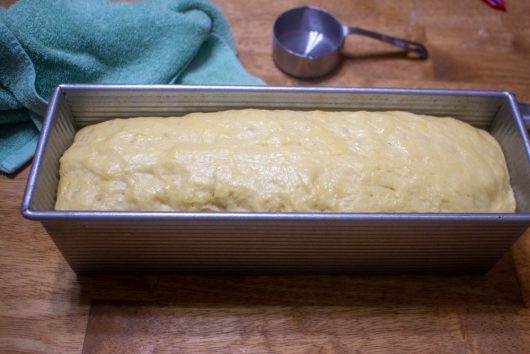
You can bake this Sally Lunn in a common 9×5-inch bread pan. I used a 13-inch pain de mie (i.e., “Pullman”) pan, simply because I wanted to create a perfectly rectangular loaf. Another option is to divide the batter between two 8×4-inch pans.
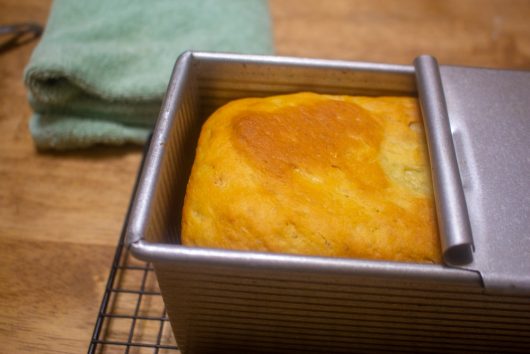 The pain de mie pan is an old-fashioned French bread pan that comes with a lid. The lid stops the bread dough from forming a crown as it rises in the oven. If you own such a pan, you might like to try my recipe for French Sandwich Bread. Click here to view it.
The pain de mie pan is an old-fashioned French bread pan that comes with a lid. The lid stops the bread dough from forming a crown as it rises in the oven. If you own such a pan, you might like to try my recipe for French Sandwich Bread. Click here to view it.
Whatever bread pan you use, I hope you’ll bake yourself a loaf of Sally Lunn. And if you do, I hope you’ll let me know how the bread worked out for you! xKevin
Hungry for more? Get my email updates.
And here’s the printable recipe:
Sally Lunn (Batter Bread)
Ingredients
- 1/2 cup warm (110-115°F) milk
- 1/2 cup unsalted butter, melted
- 1/4 cup warm (110-115°F) water
- 2 1/4 teaspoons active dry (or instant) yeast
- 1/4 cup sugar
- 3 large eggs, lightly beaten
- 3 1/2 to 4 cups all-purpose flour
- 1 1/2 teaspoons salt
- softened butter or vegetable spray for greasing the bread pan
Instructions
- In a small pot or microwave safe bowl, heat the milk and butter together on the stove top or in a microwave oven. When the butter melts, set the mixture aside and allow it to cool to 110-115°F. The mixture should feel warm (not hot!) to the touch.
- Meanwhile, in a quart-size glass measure, whisk together the water, yeast, and sugar. When the milk mixture has cooled sufficiently, add it and the eggs to the yeast mixture. Whisk briefly to combine.
- Tip 3 1/2 cups flour into a large mixing bowl. Add the salt, and stir to mix. Make a well in the center of the flour, and then add the liquid ingredients. Stir vigorously, with a stout spoon until a thick, smooth batter develops. If the batter seem soupy rather than thick, go ahead and stir in the extra 1/2 cup of flour. Cover the bowl with cling film and let rise at room temperature until doubled in volume -- about 2 hours.
- Use a spoon or spatula to gently deflate the batter. Then pour the batter into a 9x5 loaf pan or a 13-inch pain de mie ("Pullman") pan. Cover loosely with lightly-greased cling film. If using a loaf pan, let the batter rise until it forms a crown approximately 1 inch above the rim of the pan (about 45 minutes at room temperature). If using a pullman pan, let rise just until the batter reaches 1/2 below the rim (about 45 minutes), and then slide the lid on. Halfway through rising time, preheat the oven to 375°F.
- Bake in the preheated 375°F until the bread is done -- usually 45 minutes. Unmold and let cool to room temperature on a wire rack before slicing.
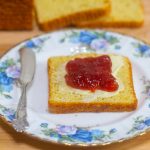

Rose says
Dear Kevin, Thank you for the interesting recipe. I am wondering if this bread can be made in a bread machine?
Kevin Lee Jacobs says
Hi Rose – Sally Lunn is a (no-knead) batter bread. Consequently I would not use a bread machine or stand mixer to manipulate the dough.
Mary H says
Where did you get the plastic wrap with the cutter?
Kevin Lee Jacobs says
Hi Mary H – Plastic wrap came from a kitchen supply store. Quite a bargain — $13.00 for 2,000 feet of wrap!
Joanie says
I was looking for a new and interesting bread recipe to make on this dreary, rainy Sunday morning. I’m off to make this right now 🙂
Kevin Lee Jacobs says
Hi Joanie – Hope you enjoy the bread!
Anne Boyle says
This looks delicious and I will make it with my 7 year old grand daughter and baking partner! I must ask- have you made any butternut squash pies/ breads with your beautiful squash?
Jan Lowe says
Good morning Kevin! I look forward to your post every Sunday, you are like a ray of sunshine on a cloudy day. We enjoy the recipes as well as tours of your beautiful home and gardens. We live in rural Saskatchewan and your yard is an inspiration for our plans with our farm yard. Thanks for the joy you share with us all!!
Lucinda Russell says
Hi Kevin,
Thanks for the lovely recipe and the not-inaccurate story of Sally Lunn. As you say, “she” was not a real person. My degrees are in history, and I put them to good use working in various museums and historic sites, including those of the US National Park Service. I conducted classes in historic cookery, and researched the origins of Sally Lunn.
Before it reached the city of Bath, England, it was a French bun, known as “Soleil et Lune,” the sun and the moon”. The sun was the golden outside, and the moon was the pale inside. When the lovely bread crossed the Channel, arriving in Bath first, girls were hired to hawk it in the streets, calling out, “Soleil et Lune”. Neither they, nor their clientele knew the French, and thought they were saying “Sally Lunn”. Undoubtedly, this is what the girls were actually saying. And so the legends of a girl named Sally Lunn grew. Nowadays, even respectable cookbooks with excellent recipes for the treat tell “her story”. I have made it many times, and folks are impressed.
Terri from Delaware says
Hi Kevin,
Wonderful looking loaf of bread.
Do you think this would work using a Gluten Free All Purpose Flour such as Krusteaz Gluten
Free All Purpose Flour. Bread is one thing I really miss since going gluten free 2 years ago.
Kevin Lee Jacobs says
Hi Anne Boyle – No butternut squash breads yet, but I did make a Butternut Squash Pie. Recipes to come!
Hi Jan – Thank you so much!
Hi Lucinda – Thank you for the history lesson! Will add your wise comment to the recipe up top.
Hi Terri – Wish I had an answer for you. If you make this bread with a gluten-free flour mix, please (please!) let me know how it turns out for you.
Virginia M says
Going to make this today to have with our spaghetti dinner tonight! I don’t have the special pan and am wondering about covering it! Should I use tin foil for a lid?
Kevin Lee Jacobs says
Hi Virginia M – You can bake the bread in a 9×5-inch loaf pan. No need for a lid — just let the bread form a crown. Enjoy!
Rose says
If they were originally buns, how would you make buns from this batter?
Kevin Lee Jacobs says
Hi Rose – For buns, I suspect the batter was baked in metal rings. Keyword: “suspect.”
Mary in Iowa says
As a lifelong history devotee, I loved reading the historical origins of this bread. Have ingredients, will bake, and I shared this on FB. Thanks, Kevin.
Kevin Lee Jacobs says
Hi Mary – Thanks so much for sharing this recipe with your FB crowd. Hope you enjoy this historic loaf!
JoAnn says
I live at 8300 feet elevation. What adjustments should I make to this recipe??
Would love to try it.
mickeyc says
Can this be made without the sugar? Thank you so much!!!
Kevin Lee Jacobs says
Hi Mickeyc – You can reduce the sugar to 2 tablespoons. Just don’t omit the sugar entirely or you won’t have Sally Lunn Bread!
Bobbie says
Hi Kevin, What kind of tool did you use to get such a nice looking even slice of bread?
Kevin Lee Jacobs says
Hi Bobbie – I baked this loaf in my Pullman pan. To learn more about the pan (and where to find one), click here.
Marcy MacDonald says
Kevin I will be making that bread this afternoon. Only one thing don’t use so much butter when you smear it on the bread. Have to watch those calories.
Michele spencer says
I love the simplicity of this bread! It looks fool proof and something guaranteed to turn out well which is always good. I am fascinated with the pullmans pan. I’ve never seen one before and I have a feeling I will be buying one just so I can make this bread. I love your videos Kevin ( and adore Binky and am so happy you nursed her to health, you’re an angel) because they are so detailed and they make me want to cook. I live all alone and have lived on cereal or sandwiches for a very long time, but you are inspiring me to put more effort into meal preparation. I would love it if you did a few meal for two recipes!
Carmen Houston says
I am so happy I found you and your delightful recipes! I made the Sally Lunn Bread and following your video and recipe it came out outstanding!! You do make everything look so easy and your voice is so calming that my fears of following recipes were diminished! I will be venturing onto another of your recipes❤️